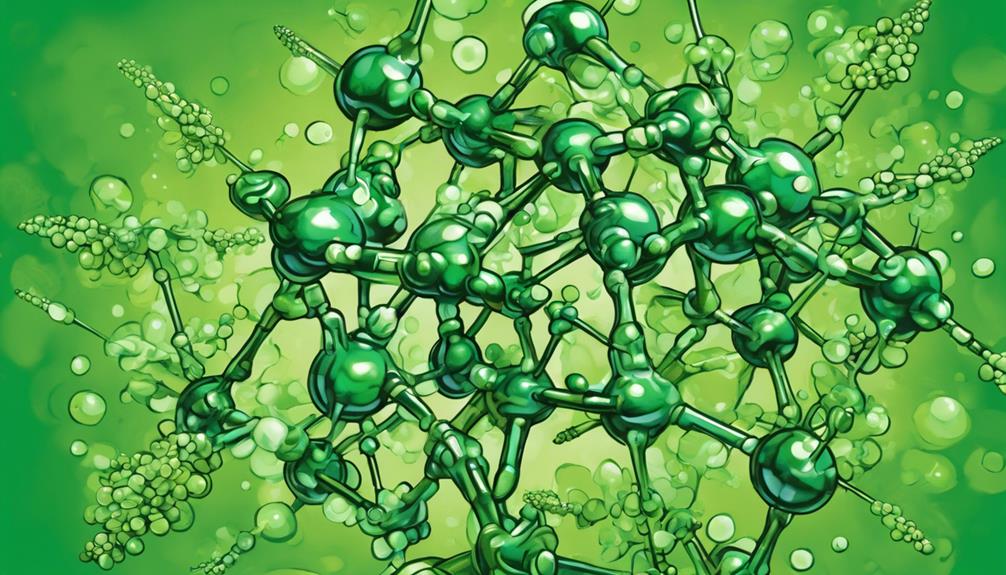Search no more than chlorophyll if you're curious about the pigment trapping solar energy in photosynthesis. Chlorophyll efficiently captures sunlight and transforms it into chemical energy, essential for plants to survive. This pigment, found mainly in chloroplasts, acts as a light receptor during photosynthesis, absorbing light energy to produce nutrients. Understanding how chlorophyll works is key to accessing the mystery of solar energy conversion in plants.
Key Takeaways
- Chlorophyll is the primary pigment that traps solar energy in photosynthesis.
- Chlorophyll molecules act as light receptors capturing sunlight for energy.
- Green plants rely on chlorophyll to convert solar energy into chemical energy.
- Carotenoids assist chlorophyll by transferring absorbed light energy for photosynthesis.
- Chloroplasts house chlorophyll and pigments critical for solar energy conversion.
Chlorophyll and Solar Energy
Chlorophyll plays an essential role in capturing solar energy efficiently during photosynthesis in plants. As the primary photosynthetic pigment, chlorophyll is housed within chloroplasts, where it absorbs sunlight and converts it into chemical energy.
Green plants heavily rely on chlorophyll to transform solar energy into usable chemical energy, necessary for their growth and survival. These chlorophyll molecules act as light receptors, capturing the needed light energy that kickstarts the photosynthesis process.
Without chlorophyll, plants would struggle to harness the power of sunlight for their metabolic processes. The presence of this photosynthetic pigment within chloroplasts is critical for converting light energy into chemical energy, enabling plants to produce glucose and oxygen.
This conversion process is essential for sustaining life on Earth, highlighting the importance of chlorophyll in the intricate mechanism of photosynthesis.
Photosynthesis Process Overview
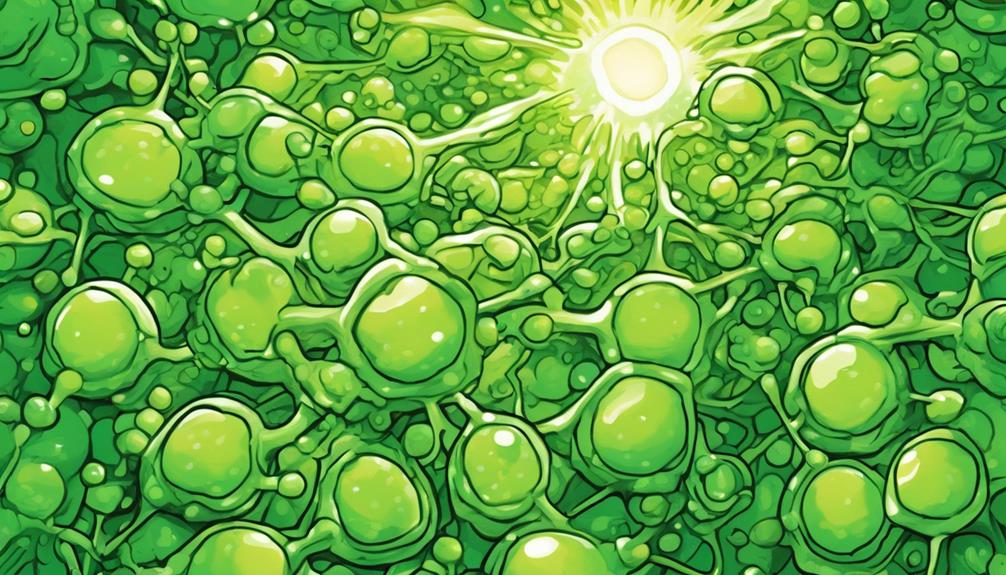
During photosynthesis, plants undergo a complex process of converting sunlight into energy to support their growth and survival. Here is an overview of the photosynthesis process:
- Solar Energy Absorption: Green plants utilize chlorophyll, a pigment found in plastids, to absorb sunlight.
- Trapping of Solar Energy: Chlorophyll, specifically chlorophyll a and b, traps solar energy during photosynthesis.
- Conversion into Chemical Energy: The absorbed solar energy is then converted into chemical energy within the plant cells.
- Role of Chloroplasts: Chlorophyll is primarily located in chloroplasts, the organelles where photosynthesis takes place. These chloroplasts are essential for housing the photosynthesis process within plant cells.
Role of Photosynthetic Pigments
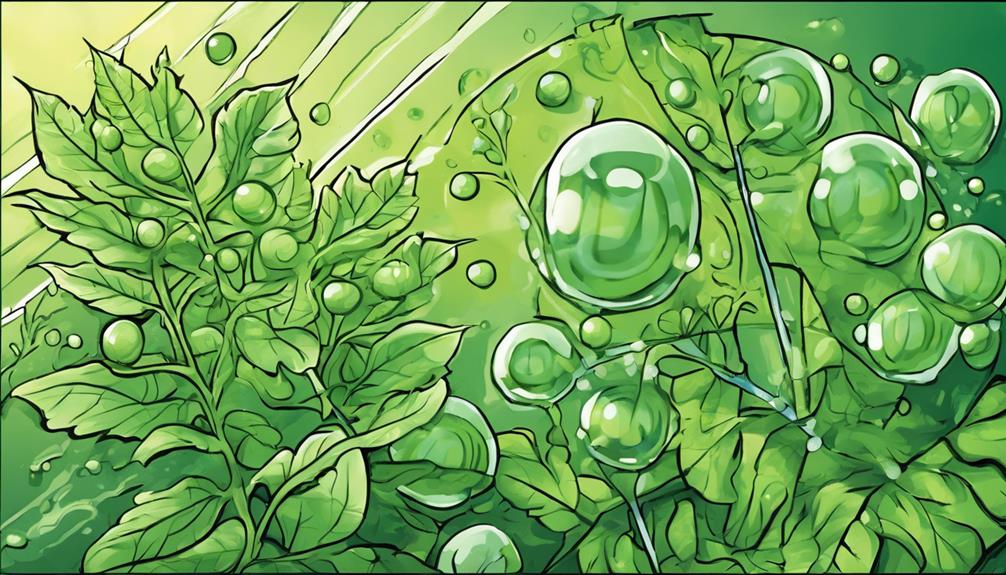
Photosynthetic pigments play a vital role in the absorption and conversion of light energy during the process of photosynthesis. Chlorophyll, the primary pigment in green plants, is essential for trapping solar energy. It absorbs light primarily in the blue, violet, and red regions of the visible spectrum.
Alongside chlorophyll, carotenoids also contribute by absorbing light energy and transferring it to chlorophyll for photosynthesis. These pigments are located within the chloroplasts of plant cells, where the photosynthetic process takes place efficiently.
The interaction between chlorophyll and carotenoids allows for best light absorption and energy conversion, facilitating the production of glucose and oxygen from carbon dioxide and water. Understanding the roles of these pigments is fundamental in comprehending how green plants harness solar energy to synthesize their own food and release oxygen into the atmosphere as a byproduct.
Understanding Chloroplast Structure
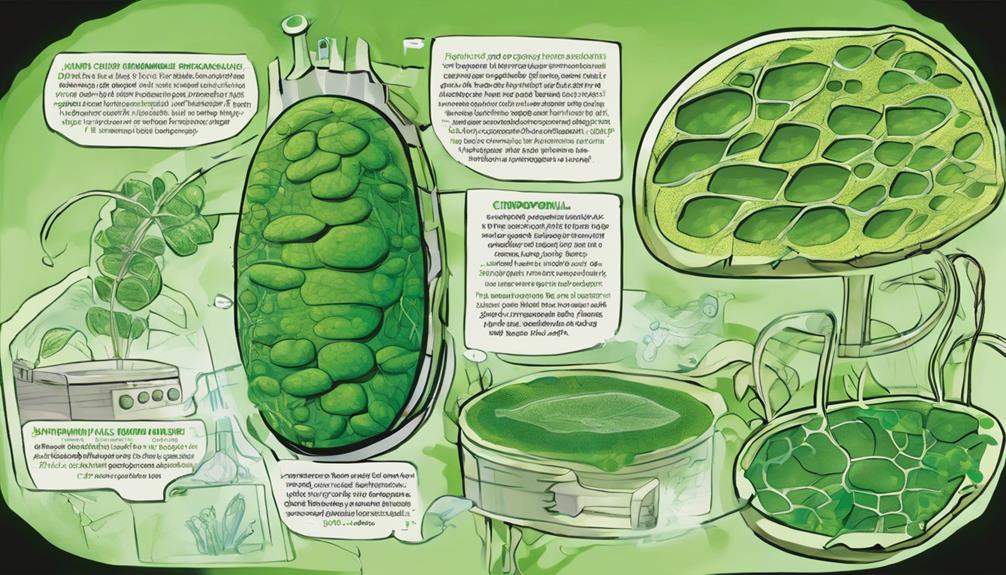
To understand the structure of chloroplasts, you must first grasp their role in trapping solar energy for photosynthesis. Within these essential organelles found in plant cells, thylakoids containing chlorophyll act as the primary site for capturing sunlight to power the photosynthesis process.
The stroma of chloroplasts, on the other hand, functions as the area where enzymes and DNA necessary for photosynthesis are housed. Chlorophyll molecules within chloroplasts are responsible for absorbing light energy in specific wavelengths, facilitating the conversion of solar energy into chemical energy necessary for plant growth and development.
Thylakoids within chloroplasts hold chlorophyll, the pigment vital for capturing light energy.
The stroma of chloroplasts contains enzymes and DNA essential for the photosynthesis process.
Chloroplasts play a critical role in capturing solar energy through chlorophyll for photosynthesis.
Chloroplasts convert light energy into chemical energy used for plant development.
Evolutionary Impact of Photosynthesis
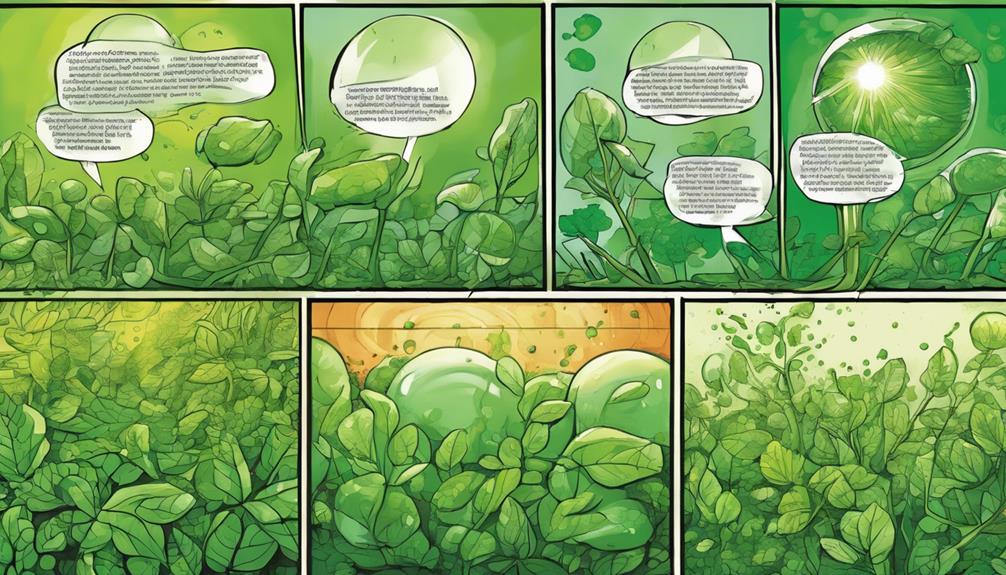
The evolutionary impact of photosynthesis spans billions of years, fundamentally altering Earth's atmosphere and paving the way for the emergence of diverse life forms. Photosynthesis, initially catalyzed by cyanobacteria around 2.5 billion years ago, played a pivotal role in transforming Earth's atmosphere by producing oxygen.
Subsequent advancements by algae and plants further refined the process, leading to the evolution of various organisms and shaping life on Earth. This evolutionary journey extensively impacted the composition of Earth's atmosphere, fostering oxygen-rich environments essential for the development and sustenance of life.
Through the collaborative efforts of photosynthetic organisms like algae, plankton, and plants, oxygen levels in the atmosphere have been regulated over time, supporting the intricate web of life on our planet. The evolution of photosynthesis not only revolutionized Earth's atmosphere but also laid the foundation for the diverse ecosystems and organisms that thrive today, highlighting the enduring evolutionary impact of this fundamental process.
Frequently Asked Questions
What Pigment Traps Solar Energy for the Process of Photosynthesis?
To trap solar energy for photosynthesis, chlorophyll, the primary pigment in plants, absorbs sunlight in chloroplasts. It converts light energy into chemical energy, utilizing blue and red light regions. This process gives plants their green color.
What Pigment Traps Sunlight Energy for Photosynthesis?
To capture sunlight energy for photosynthesis, chlorophyll, a green pigment in plants, plays an essential role. Absorbing light in the blue and red spectrum, chlorophyll converts solar energy into chemical energy, fueling plant growth.
What Pigment Is Solar Energy Observed by in Photosynthesis?
In photosynthesis, solar energy is observed by chlorophyll, the pigment that captures sunlight for plant growth. Chlorophyll molecules, found in chloroplasts, convert light into chemical energy, important for plants to produce glucose and oxygen.
What Is the Name of the Pigment That Absorbs Solar Energy During Photosynthesis?
During photosynthesis, the pigment that absorbs solar energy is chlorophyll. It's located in plant chloroplasts and absorbs sunlight in the blue and red regions. Without it, plants couldn't efficiently convert light energy into chemical energy.
How Does the Pigment in Photosynthesis Compare to the Type of Solar Power System That Converts Light Energy Into Electrical Energy?
In photosynthesis, pigments such as chlorophyll absorb light energy and convert it into chemical energy. Similarly, solar power systems that convert light energy utilize photovoltaic cells to generate electrical energy. Both processes rely on capturing and transforming light energy into a usable form, albeit through different mechanisms.
How Does the Pigment in Photosynthesis Compare to the Solar Power System?
The pigment in photosynthesis absorbs sunlight to convert carbon dioxide and water into glucose and oxygen. Similarly, different solar power system types harness sunlight to generate electricity. Both processes rely on the sun’s energy, but photosynthesis occurs in plants, while solar power systems are man-made technologies.
Conclusion
So, now you know that chlorophyll is the superstar pigment that captures sunlight in photosynthesis.
Just like a skilled artist with their paintbrush, chlorophyll works tirelessly to turn sunlight into energy for plants.
Next time you see a green leaf glistening in the sun, remember that it's all thanks to the amazing power of chlorophyll.
Keep shining bright like the sun, just like chlorophyll does for plants!
